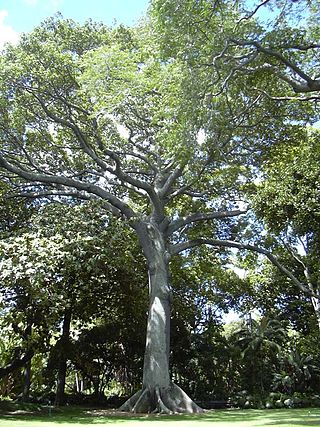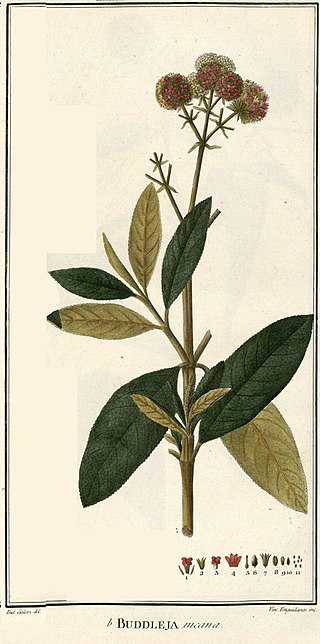
Ceiba pentandra is a tropical tree of the order Malvales and the family Malvaceae, native to Mexico, Central America and the Caribbean, northern South America, and West Africa. A somewhat smaller variety was introduced to South and Southeast Asia, where it is cultivated.

Quercus suber, commonly called the cork oak, is a medium-sized, evergreen oak tree in the section Quercus sect. Cerris. It is the primary source of cork for wine bottle stoppers and other uses, such as cork flooring and as the cores of cricket balls. It is native to southwest Europe and northwest Africa. In the Mediterranean basin the tree is an ancient species with fossil remnants dating back to the Tertiary period.

Cuban cuisine is largely based on Spanish cuisine with influence from African and other Caribbean cuisines. Some Cuban recipes share spices and techniques with Spanish, African and Taino cooking, with some Caribbean influence in spice and flavor. This results in a blend of the several different cultural influences. A small but noteworthy Chinese influence can also be accounted for, mainly in the Havana area. There is also some Italian influence. During colonial times, Cuba was an important port for trade, and the Spanish ancestors of Cubans brought with them the culinary traditions of different parts of Spain.
The guaracha is a genre of music that originated in Cuba, of rapid tempo and comic or picaresque lyrics. The word had been used in this sense at least since the late 18th and early 19th century. Guarachas were played and sung in musical theatres and in working-class dance salons. They became an integral part of bufo comic theatre in the mid-19th century. During the later 19th and the early 20th century the guaracha was a favourite musical form in the brothels of Havana. The guaracha survives today in the repertoires of some trova musicians, conjuntos and Cuban-style big bands.

Cyrilla racemiflora, the sole species in the genus Cyrilla, is a flowering plant in the family Cyrillaceae, native to warm temperate to tropical regions of the Americas, from the southeastern United States, south through the Caribbean, Mexico and Central America to northern Brazil and Venezuela in South America. Common names include swamp cyrilla, swamp titi, palo colorado, red titi, black titi, white titi, leatherwood, ironwood, he huckleberry, and myrtle.

Spondias mombin, also known as yellow mombin or hog plum is a species of tree and flowering plant in the family Anacardiaceae. It is native to the tropical Americas, including the West Indies. The tree was introduced by the Portuguese in South Asia in the beginning of the 17th century. It has been naturalized in parts of Africa, India, Nepal, Bangladesh, Sri Lanka, The Bahamas, Indonesia, and other Caribbean islands. It is rarely cultivated except in parts of the Brazilian Northeast.
Bactris jamaicana is a spiny palm which grows in multi-stemmed clumps. It is endemic to Jamaica.

Laurelia sempervirens is a species of evergreen tree in the family Atherospermataceae. Common names include Peruvian nutmeg, tihue or trihue, and Chilean laurel or Chilean sassafras.

Magnolia polyhypsophylla is a species of plant in the family Magnoliaceae. It is endemic to Colombia. It is known commonly as almanegra de ventanas.

Schoepfia arenaria is an extremely rare species of hemiparasitic flowering plant in the Schoepfiaceae family. It grows as a small, multi-trunked tree. It is endemic to Puerto Rico, where it is found growing along the northern coast. A local Spanish vernacular name recorded for this tree is araña ('spider'). It has no common name in English.

Beilschmiedia berteroana is a threatened evergreen tree in the family Lauraceae native to Chile at 35 to 37°S.

Citronella mucronata, the huillipatagua or Chilean citronella tree, is an evergreen tree native to Chile, it occurs from 30 to 41° South latitude. In Chile, the tree grows from 500 to 2000 meters above sea-level in low altitude interior valleys and coastal mountains.

Peperomia pellucida is an annual, shallow-rooted herb, usually growing to a height of about 15 to 45 cm, it is characterized by succulent stems, shiny, heart-shaped, fleshy leaves and tiny, dot-like seeds attached to several fruiting spikes. It has a mustard-like odor when crushed.

Gliricidia sepium, often simply referred to as its genus name Gliricidia, is a medium size leguminous tree belonging to the family Fabaceae. Common names include quickstick, mata ratón; cacao de nance, cachanance; balo in Panama; piñon Cubano in the Dominican Republic; madreado in Honduras; kakawate in the Philippines; madre xacao, madre cacao, or madre de cacao in the Philippines and Guatemala; madero negro in Nicaragua; undirmari in Marathi and wetahiriya in Sinhala). It is an important multi-purpose legume tree, with a native range from Mexico to Colombia, but now widely introduced to other tropical zones.
Cuban musical theatre has its own distinctive style and history. From the 18th century to modern times, popular theatrical performances included music and often dance as well. Many composers and musicians had their careers launched in the theatres, and many compositions got their first airing on the stage. In addition to staging some European operas and operettas, Cuban composers gradually developed ideas which better suited their creole audience. Characters on stages began to include elements from Cuban life, and the music began to reflect a fusion between African and European contributions.

Buddleja incana is a species of shrub or tree in the family Scrophulariaceae. It is native to the Andes.

Sterculia apetala, commonly known as the Panama tree, camoruco, manduvi tree or anacagüita, is a species of flowering plants in the family Malvaceae. It is found in Central and South America, as well as the Caribbean islands. Sterculia apetala is recognized as the national tree of the Republic of Panama.
Félix Ramos y Duarte (1848–1924) was a Cuban educator and writer, who was exiled from Cuba in 1868. He moved to Yucatán, Mexico and later lived in Veracruz and Mexico City. He compiled the first dictionary of terms that were specifically "Mexican Spanish". Ramos returned to Cuba after it gained independence from Spain. He taught briefly and then served as President of the Teacher Examination Board. He published many textbooks and educational articles.
Myrceugenia colchaguensis is a species of small evergreen tree in the genus Myrceugenia of the family Myrtaceae. It is endemic to Chile where it is found in the coastal mountain range at altitudes below 400 m (1,312 ft). Common names by which this tree is known include colchaguillo, arrayan de colchagua and lumilla.

Cayo Hueso is a consejo popular (ward) in the municipality of Centro Habana, Havana, Cuba. A traditionally working-class neighborhood populated by Afro-Cubans, it is known for its many cultural landmarks such as the Callejón de Hamel, the Fragua Martiana Museum and the Parque de los Mártires Universitarios.




















